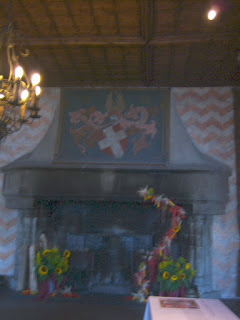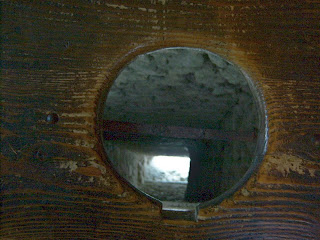Finding Santa Claus, and a Black Madonna, in Unexpected Places.
Chillon Castle, Lake Geneva, Switzerland
Chillon Castle, Lake Geneva, Switzerland
Join a tour, have to keep up. But, if you go on your own, you can stay as long as you like, and find things. Here, start looking at frescoes, wall and ceiling paintings, and heraldry. Some things bowl you over.
A. We found Santa Claus.
Yes. He is not at the North Pole. He is on Lake Geneva, Chillon Castle heraldry room, confronting a big black bear - possibly a Bern image, but what about Santa? Or is that a black dragon? The heraldry Griffon, perhaps, also spelled "Griffin" - see ://www.isidore-of-seville.com/griffins/9.html/. Or Gryphon. There are littler cute griffins or gryphons showing below, black against red griffins there? Who prevailed: it looks like the red griffin is bottom up. It looks like waves around, or big winds, black and white again and the red Santa. For heraldry, start at ://www.heraldicsculptor.com/heraldry.html/.
Back to Chillon: Find a clue: "Frederic de Gingins." Who? This is really odd.
First, Santa: No clue from our fast look-ups. But it is there. Hoax?
1. Frederic de Gingins as Baron de Gingins, whose name apppears beneath some unusual (anachronistic?) heraldry in the heraldry hall at Chillon Castle, Switzerland. He is in a google book now, at "Historic Studies in Vaud, Berne and Savoy; from Roman Times to Voltaire, Rousseau and Gibbon" by an English General Meredith Read (family connections to America, Virginia; Civil War era accomplishments noted) at ://www.archive.org/stream/historicstudies00readgoog/historicstudies00readgoog_djvu.txt/ This is full of Gingins references - skimmed for Santa or a Saint Nicholas or something, did not find. But long long history of Ginginses.
All that is fine, but when and why and how the Santa? As a Vaudois nobleman, he is listed as Frederic Gingins-La-Sarra, 1790-1863, or La Sarraz (see Author Index at ://fmg.ac/MGR/Indices/Sources/Authors/Links/G.htm/), a historian specializing in medieval times who sometimes went beyond his documents to make something what he wanted it to say, see ://1911encyclopedia.org/Switzerland/. Antoine-Charles de Gingins. Ancestry.com has an 1859 geneology you can order. Is Santa home? Part of the Sires de Montfaucon comtes de Montbeliard.
2. There is a "Christmas Market" in Montreux, town just down from Chillon Castle (is it in Montreux?), but that looks modern, but then again so does this odd Santa, see ://switzerland-travel.suite101.com/article.cfm/visit_the_romantic_montreux_christmas_market/ The heraldry is a hoax? Ok. Here is a long history of Switzerland: at ://1911encyclopedia.org/Switzerland/ No mention.
3. This is not St. Nicolas of Myra, patron saint of children, see ://www.civicheraldry.co.uk/ecclesiastical.html/ and there are no ecclesiastical hats or flock hooks here either. See also ://www.civicheraldry.com/page/7297/ Swiss civic heraldry is indexed at ://www.civicheraldry.com/region/switzerland/ Have not been through them all.
B. And a Black Madonna at Chillon.
We found a Black Madonna. This time, up high.
We have seen free-standing paintings of Black Madonnas, and statues. There are many, and varied in explanations and places in Europe, and, we understand, elsewhere in the New World. See, an outdated, but good for a start, our collection at an earlier time at Europe Road Ways, Themes, Black Madonnas.
Here we find our first Black Madonna painting on a ceiling, a ceiling fresco, or, perhaps, it is just a painting there. Fresco, on the other hand, is a special technique, that means painting on wet plaster so it lasts a long time - we don't know which this Chillon ceiling painting is. Fresco: see the Italians who were especially good at it, at ://www.italianfrescoes.com/frescoTechnique.asp.
Here is the Black Madonna we found at Chillon Castle:
What is the history? We cannot find it. But there are many other black figures at Chillon, and black-white motifs. Being researched. We see reference to a Madonna da Vico at ://www.archive.org/stream/santuarioofmadon00rossuoft/santuarioofmadon00rossuoft_djvu.txt/, but an Images search of Madonna of Vico shows nothing like this. Even Dorothy Dix in 1926 makes no mention of this in her travel journal from the US to Eastern Europe, this part at Chillon, see ://library.apsu.edu/dix/lettersanddiaries/diary1926.htm/.
Comment, approach audience from stage: Are we at the point in travel like, with news, all we can get is people's rehash on tours of what someone else said or did. Look at fact content anywhere. Where are facts. Nowhere to be found. We get opinions and views in place of news, and in places that are labeled "news" and aren't p they are opinions and propaganda.
Nuts. As with art. Where are the facts. Here, in art, same thing. We get tours with see this, see that, and the people do, click the same pictures, and leave. What about all the rest? The things that are there, but ignored, and who knows what they are. Enough. Somebody pick up on these, however, because they are fun.
 Santa Claus in Heraldry, Frederic de Gingins, at Chillon Castle, Switzerland. Santa here. Yes, Santa.
Santa Claus in Heraldry, Frederic de Gingins, at Chillon Castle, Switzerland. Santa here. Yes, Santa. Black Madonna, ceiling (fresco or painting?) Chillon Castle, Switzerland (and black child)
Black Madonna, ceiling (fresco or painting?) Chillon Castle, Switzerland (and black child) Security checkpoints, Castle Chillon, defenses.
Security checkpoints, Castle Chillon, defenses. Clothing chests, or other household goods, wooden-carved, Chillon Castle, Switzerland
Clothing chests, or other household goods, wooden-carved, Chillon Castle, Switzerland Religious theme: Adam and Eve and, oh, no, a female snake (the Bible says the snake was a "he"); all the better for dogma, my dear. Castle Chillon, Switzerland
Religious theme: Adam and Eve and, oh, no, a female snake (the Bible says the snake was a "he"); all the better for dogma, my dear. Castle Chillon, Switzerland Women in War. Woman's armor? Chillon Castle collection, second from left, Switzerland
Women in War. Woman's armor? Chillon Castle collection, second from left, Switzerland Fireback, Chillon Castle, Switzerland
Fireback, Chillon Castle, Switzerland Bed, Chillon Castle, Switzerland; portable. Guide said Duke took furnishings with him castle to castle.
Bed, Chillon Castle, Switzerland; portable. Guide said Duke took furnishings with him castle to castle. Roofed battlements structure, post and beam, Chillon Castle, Lake Geneva, Switzerland
Roofed battlements structure, post and beam, Chillon Castle, Lake Geneva, Switzerland Large medieval fireplace with overhang, not heat-efficient, Chillon Castle, Switzerland
Large medieval fireplace with overhang, not heat-efficient, Chillon Castle, Switzerland Castle Chillon, an island now bridged, Lake Geneva, Switzerland
Castle Chillon, an island now bridged, Lake Geneva, Switzerland Chillon Castle, View from the Prison at water level,above an unloading dock, Lake Geneva, Switzerland
Chillon Castle, View from the Prison at water level,above an unloading dock, Lake Geneva, Switzerland Courtyard and fortified storage area, perhaps prison off and on, Castle Chillon, Switzerland
Courtyard and fortified storage area, perhaps prison off and on, Castle Chillon, Switzerland Outer walls, Chillon Castle, Switzerland
Outer walls, Chillon Castle, Switzerland Escape hatch or treasure storage? Put a rug on top. Chillon Castle, Switzerland
Escape hatch or treasure storage? Put a rug on top. Chillon Castle, Switzerland Passageway door, to area between walls; too narrow for armor, just slip in and slip out, Castle Chillon, Switzerland. Boudoir? Council room? We recall boudoir. Check for us.
Passageway door, to area between walls; too narrow for armor, just slip in and slip out, Castle Chillon, Switzerland. Boudoir? Council room? We recall boudoir. Check for us. Folding stairs, castle defense, Castle Chillon, Switzerland
Folding stairs, castle defense, Castle Chillon, Switzerland Courtyard staircase to battlements, Chillon Castle, Switzerland
Courtyard staircase to battlements, Chillon Castle, Switzerland Tower-top prison room, with manacles, Chillon Castle, Switzerland
Tower-top prison room, with manacles, Chillon Castle, Switzerland Castle toilet. Garderobe. A one-holer, lookig down to lake. The necessary. Chillon Castle, Switzerland. Also useful for invading climbers. Look before you sit.
Castle toilet. Garderobe. A one-holer, lookig down to lake. The necessary. Chillon Castle, Switzerland. Also useful for invading climbers. Look before you sit. Chimney pots, baffles for cinders from fireplaces, Chillon Castle, Switzerland>
Chimney pots, baffles for cinders from fireplaces, Chillon Castle, Switzerland> A two-holer, more Necessaries, Chillon Castle, Switzerland (with guard)
A two-holer, more Necessaries, Chillon Castle, Switzerland (with guard) A two-holer with arrow slit above for defense when not otherwise in use, Chillon Castle, Switzerland
A two-holer with arrow slit above for defense when not otherwise in use, Chillon Castle, Switzerland Chillon Castle tourist who thinks sensible castle plumbing is fun
Chillon Castle tourist who thinks sensible castle plumbing is fun Not fun. Torture table. Chillon Castle, Switzerland
Not fun. Torture table. Chillon Castle, Switzerland Chillon Castle, Lake Geneva, Switzerland
Chillon Castle, Lake Geneva, Switzerland Drawbridge, now entry, Castle of Chillon, Lake Geneva, Switzerland
Drawbridge, now entry, Castle of Chillon, Lake Geneva, Switzerland Stair to the dungeons, Chillon Castle, Lake Geneva, Switzerland
Stair to the dungeons, Chillon Castle, Lake Geneva, Switzerland Supplies casks, dungeon area, Chillon Castle, Lake Geneva, Switzerland
Supplies casks, dungeon area, Chillon Castle, Lake Geneva, Switzerland Old log staircases, from rooms in dungeon, Chillon Castle, Lake Geneva, Switzerland
Old log staircases, from rooms in dungeon, Chillon Castle, Lake Geneva, Switzerland Chamber after chamber, dungeons, Chillon Castle, Lake Geneva, Switzerland
Chamber after chamber, dungeons, Chillon Castle, Lake Geneva, Switzerland Stake and chain, dungeons, Prisoner of Chillon, Chillon Castle, Lake Geneva, Switzerland
Stake and chain, dungeons, Prisoner of Chillon, Chillon Castle, Lake Geneva, Switzerland Waterlevel view, dungeon, Castle of Chillon, Lake Geneva, Switzerland
Waterlevel view, dungeon, Castle of Chillon, Lake Geneva, Switzerland A way out The prisoner is released. Castle of Chillon, Lake Geneva, Switzerland
A way out The prisoner is released. Castle of Chillon, Lake Geneva, Switzerland Bernese mobile artillery, Castle at Chillon, Lake Geneva; military advantage, freeing the Prisoner of Chillon?
Bernese mobile artillery, Castle at Chillon, Lake Geneva; military advantage, freeing the Prisoner of Chillon? Villeneuve, Switzerland, Alps backdrop
Villeneuve, Switzerland, Alps backdrop Lake Geneva, Villeneuve, Switzerland
Lake Geneva, Villeneuve, Switzerland Promenade dock, Villeneuve, Switzerland, Lake Geneva
Promenade dock, Villeneuve, Switzerland, Lake Geneva View, Villeneuve to Montreux, Lake Geneva, Switzerland
View, Villeneuve to Montreux, Lake Geneva, Switzerland Lakeside park, Villeneuve, Switzerland, with sports sculpture
Lakeside park, Villeneuve, Switzerland, with sports sculpture Great Saint Bernard Pass, with bridge over gap, Alps, Italy
Great Saint Bernard Pass, with bridge over gap, Alps, Italy Passport checkpoint (Switzerland not in EU), summit, Gran San Bernardo Pass
Passport checkpoint (Switzerland not in EU), summit, Gran San Bernardo Pass Summit lake, Gran San Bernardo Pass, Alps, Italy-Swiss border
Summit lake, Gran San Bernardo Pass, Alps, Italy-Swiss border Monastery and hostel complex, refuge, Gran San Bernardo Pass, Swiss side
Monastery and hostel complex, refuge, Gran San Bernardo Pass, Swiss side Car-motorcycle accident (no injuries) at summit, Gran San Bernardo Pass, Swiss side
Car-motorcycle accident (no injuries) at summit, Gran San Bernardo Pass, Swiss side Saint Bernard rescue dog, Great Saint Bernard Pass, Italy
Saint Bernard rescue dog, Great Saint Bernard Pass, Italy Saint Bernard rescue dogs, Gran San Bernardo Pass, Italy. Exercising, with handlers.
Saint Bernard rescue dogs, Gran San Bernardo Pass, Italy. Exercising, with handlers. Saint Bernard rescue dog, close-up, Gran San Bernardo Pass, Alps, Swiss Side
Saint Bernard rescue dog, close-up, Gran San Bernardo Pass, Alps, Swiss Side Napoleon and some 30,000 passed this way, graphic photo, St. Bernard Pass, Alps, Switzerland side.
Napoleon and some 30,000 passed this way, graphic photo, St. Bernard Pass, Alps, Switzerland side. Napoleon, commanding respect, Gran San Bernardo Pass, Alps, Switzerland side
Napoleon, commanding respect, Gran San Bernardo Pass, Alps, Switzerland side Black Madonna, copy from Jasna Gora monastery, Czestochowa, Poland. Several variations are there.
Black Madonna, copy from Jasna Gora monastery, Czestochowa, Poland. Several variations are there.